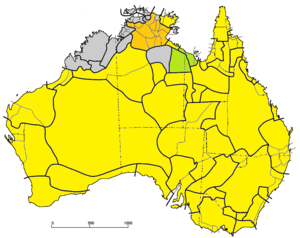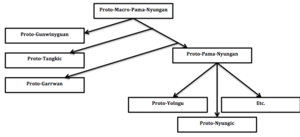Macro-Pama–Nyungan languages facts for kids
Quick facts for kids Macro-Pama–Nyungan |
|
|---|---|
| Geographic distribution: |
northern Australia |
| Linguistic classification: | Proposed language family |
| Subdivisions: | |
 Pama–Nyungan (yellow), Garawa and Tangkic (green), and Macro-Gunwinyguan (orange)
|
|
Macro-Pama-Nyungan is a name for a suggested group of Indigenous Australian languages. It was first used by linguist Nicholas Evans in 1996. He thought that two very large Aboriginal language families might have come from the same ancient language.
These two main families are the Macro-Gunwinyguan family from northern Australia and the widespread Pama–Nyungan family. The Pama–Nyungan family covers most of mainland and southern Australia. Because experts disagree on how Australian languages are related, Macro-Pama-Nyungan is still a debated idea. Many linguists who study Aboriginal languages do not fully agree with this grouping.
As of 2020, the idea of Macro-Pama-Nyungan is still being studied. It's hard to rebuild ancient Indigenous Australian language families because there isn't much information left.
Here's how the proposed language families might be connected:
|
|||||||||||||||||||
Contents
What is Macro-Pama-Nyungan?
The name "Macro-Pama-Nyungan" was created in a 1997 book by Australian linguist Nicholas Evans. It refers to a proposed large group of Indigenous Australian languages. These languages might share a common origin. They are found across Australia, from Arnhem Land in the north to southwestern Australia.
Evans has written several books about this idea. He suggests that most Indigenous languages in Australia come from one shared ancient language. He believes they all have a common ancestor.
According to Evans, the Macro-Pama-Nyungan group includes several families. These are the Gunwinyguan languages from Arnhem Land. It also includes the Tangkic languages from Mornington Island in Queensland. The Garrwan languages from Queensland and the Northern Territory are also part of it. Finally, the huge Pama–Nyungan language family is included. This family covers about 90% of Australia. The "macro" part of the name comes from adding the Gunwinyguan, Tangkic, and Garrwan families to the Pama–Nyungan family.
Before this, American linguist Kenneth L. Hale identified the Pama–Nyungan language family in 1964. He said it was one closely related family that spread across most of Australia. He also noted about a dozen other families mainly along the North coast. Evans believes that three of these northern families—Gunwinyguan, Tangkic, and Garrwan—are closely related to Pama–Nyungan. He thinks they should all be grouped under Macro-Pama-Nyungan.
Many Indigenous Australian languages have sadly disappeared. Others are in danger of disappearing. Because of this, linguists know that classifying language families is a difficult task. More research is needed, and the methods used are still debated.
How Languages Spread
It's hard to study how ancient languages were connected. This is because there isn't much information left from the past. Linguists look at how words are borrowed between groups. This helps them guess how people lived and moved around in ancient Australia.
Experts often debate whether language similarities come from a shared ancestor or from groups meeting later. This debate affects whether Macro-Pama-Nyungan is considered a real language family.
One idea is that the Pama–Nyungan family grew large because of climate changes. People might have moved to new areas that were easier to live in. This spread could have happened at different times in history. For example, it might have been when Australia was first settled or after the last Ice Age.
Another idea suggests that new tools and farming methods helped the Pama–Nyungan languages spread. This might have happened in the middle of the Holocene period. Linguists think that Pama–Nyungan languages spread with new cultural ideas. These ideas might have helped them mix with or take over existing hunter-gatherer groups. This could be linked to the arrival of the dingo or new stone tools.
Research suggests that the earliest groups to split from the Pama–Nyungan family were in the west, south, and the Tangkic area. These groups spread across South Australia, Western Australia, the Northern Territory, Victoria, New South Wales, and Southeast Queensland. Some experts think that rivers and coastlines might have been starting points for groups to split and spread their languages.
Debates on Language Classification
Many Indigenous Australian languages are now extinct. This means there is not much language evidence left. So, linguists use clues from geography, genetics, archaeology, and other languages. They use these clues to try and figure out how language families are connected. However, experts often disagree on whether these methods are reliable. This leads to many debates about how Indigenous Australian language families should be grouped.
It's still not clear if the Gunwinyguan, Tangkic, and Garrwan families can be grouped under Macro-Pama-Nyungan. This is because their connection to the Pama–Nyungan family is still being questioned. Evans's way of classifying the Gunwinyguan family is not always clear. This is because he uses some new methods that are not yet widely accepted. However, some linguists like Rebecca Green say that shared patterns in verbs suggest Gunwinyguan is part of Macro-Pama-Nyungan.
Evans also suggests that the Gunwinyguan family might be a "sister" to the Macro-Pama-Nyungan family. This larger family would include Tangkic, Garrwan, and the main Pama–Nyungan languages. The Tangkic languages are thought to be one of the earliest branches of the Greater-Pama-Nyungan family. Some linguists believe Tangkic is closely related to the Pama–Nyungan Yolŋu languages.
Why Some Disagree
The idea of Macro-Pama-Nyungan is not fully accepted. Many linguists who study Aboriginal Australian languages disagree with it. This is because there isn't enough strong evidence. Also, the methods used to connect language families are sometimes questioned.
Linguist Bowern says that the Macro-Pama-Nyungan language tree model used by Evans has "very little evidence." She points out that each connection in the tree is based on only one shared feature. Other linguists also say that there are several non-Pama-Nyungan groups that show the proposed link between the Garrwan family and the Pama–Nyungan Yolŋu family is not correct.
Bowern argues that the Gunwinyguan family includes languages from Arnhem Land that are not closely related to the Pama–Nyungan family. This challenges the idea of grouping Gunwinyguan, Tangkic, and Garrwan under Macro-Pama-Nyungan. Both McConvell and Bowern also note that Gunwinyguan cannot be both a sister to Macro-Pama-Nyungan and part of the Arnhem family at the same time.
See also
 In Spanish: Lenguas macro-pama-ñunganas para niños
In Spanish: Lenguas macro-pama-ñunganas para niños


